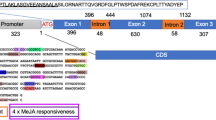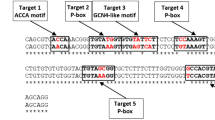Abstract
In this communication, we report the binding of abscisic acid responsive elements (ABREs) of rice Osem, namely motif A and motif B, with a cognate trans-acting factor present in the nuclear extract of tobacco leaf. The binding is specific as both the complexes were disrupted with an excess of homologous non-radioactive DNA like motif A or motif B themselves or with cis-elements of rice Rab16A, motif I (ABRE) and motif IIa (non-ACGT ABRE-like sequences). Four tandem repeats of ABRE from wheat Em (4X ABRE) or two tandem repeats of Em ABRE, plus two copies of coupling element (CE1) from barley HVA22 (2X ABRC), also showed specific complexes, that were competed out by an excess of homologous competitors like motif I, motif IIa, motif A, motif B, 4X ABRE and 2X ABRC, but not by the unrelated 4X DRE sequence. Elution of the protein from all the complexes showed a single 26 kDa polypeptide band. Introgression of two of the above synthetic promoters 4X ABRE and 2X ABRC, each fused with minimal promoter of cauliflower mosaic virus 35S (CaMV 35S), could induce the expression of the reporter gene β-glucuronidase (gus) in transgenic tobacco in response to high NaCl concentration, dehydration or abscisic acid, but not at the constitutive level, proving that they can be used as efficient stress-inducible promoters. Our work shows both in vivo and in vitro activity of the promoters from monocot genes in the model dicot plant tobacco.
Similar content being viewed by others
Abbreviations
- ABRE:
-
abscisic acid responsive element
- ABRC:
-
abscisic acid responsive complex
- CaMV 35S:
-
cauliflower mosaic virus 35S
- CE:
-
coupling element
- DRE:
-
dehydration responsive element
- EMSA:
-
electrophoretic mobility shift assay
- gus :
-
β-glucuronidase gene
- PEG:
-
polyethylene glycol
References
An, G.: Binary ti vectors for plant transformation and promoter analysis. — Methods Enzymol. 153: 292–293, 1987.
Blum, H., Beier, H., Gross, H.J.: Improved silver staining of plant proteins, RNA and DNA in polyacrylamide gel. — Electrophoresis 8: 93–99, 1987.
Bradford, M.M.: A rapid and sensitive method for the quantitation of microgram quantities of protein utilizing the principle of protein-dye binding. — Anal. Biochem. 72: 248–254, 1976.
Busk, P.K., Pages, M.: Regulation of abscisic acid-induced transcription. — Plant mol. Biol. 37: 425–435, 1998.
Cherian, S., Reddy, M.P., Ferreira, R.B.: Transgenic plants with improved dehydration-stress tolerance: progress and future prospects. — Biol. Plant. 50: 481–495, 2006.
Cousson, A.: Involvement of phospholipase C-independent calcium-mediated abscisic acid signalling during Arabidopsis response to drought. — Biol. Plant. 53: 53–62, 2009.
Furtado, A., Henry, R.J.: The wheat Em promoter drives reporter gene expression in embryo and aleurone tissue of transgenic barley and rice. — Plant Biotechnol. J. 3: 421–434, 2005.
Guiltinan, M.J., Marcotte, W.R., Jr., Quatrano, R.S.: A plant leucine zipper protein that recognizes an abscisic acid response element. — Science 250: 267–271, 1990.
Hattori, T., Terada, T., Hamasuna, S.: Regulation of the Osem gene by abscisic acid and the transcriptional activator VP1: analysis of cis-acting promoter elements required for regulation by abscisic acid and VP1. — Plant J. 7: 913–925, 1995.
Hattori, T., Totsuka, M., Hobo, T., Kagaya, Y., Yamamoto-Toyoda, A.: Experimentally determined sequence requirement of ACGT-containing abscisic acid response element. — Plant Cell Physiol. 43: 136–140, 2002.
Hobo, T., Asada, M., Kowyama, Y., Hattori, T.: ACGTcontaining abscisic acid response element (ABRE) and coupling element 3 (CE3) are functionally equivalent. — Plant J. 19: 679–689, 1999.
Huang, C., Guo, T., Zheng, S.C., Feng, Q.L., Liang, J.H., Li, L.: Increased cold tolerance in Arabidopsis thaliana transfromed with Choristoneura fumiferana glutahione Strasferase gene. — Biol. Plant. 53: 183–187, 2009.
Ishige, F., Takaichi, M., Foster, R., Chua, N.H., Oeda, K.: A Gbox motif (GCCACGTGCC) tetramer confers high-level constitutive expression in dicot and monocot plants. — Plant J. 18: 443–448, 1999.
Katagiri, F., Lam, E., Chua, N.H.: Two tobacco DNA-binding proteins with homology to the nuclear factor CREB. — Nature 340: 727–730, 1989.
Kosova, K., Vitámvás, P., Prášil, I.T.: The role of dehydrins in plant response to cold. — Biol. Plant. 51: 601–617, 2007.
Longhurst, T., Lee, E., Hinde, R., Brady, C., Speirs, J.: Structure of the tomato Adh2 gene and Adh2 pseudogenes, and a study of Adh2 gene expression in fruit. — Plant mol. Biol. 26: 1073–1084, 1994.
Marcotte, W.R., Jr., Russell, S.H., Quatrano, R.S.: Abscisic acid-responsive sequences from the em gene of wheat. — Plant Cell 1: 969–976, 1989.
Mukherjee, K., Choudhury, A.R., Gupta, B., Gupta, S., Sengupta, D.N.: An ABRE-binding factor, OSBZ8, is highly expressed in salt tolerant cultivars than in salt sensitive cultivars of indica rice. — BMC Plant Biol. 6: 18, 2006.
Mundy, J., Chua, N.H.: Abscisic acid and water-stress induce the expression of a novel rice gene. — EMBO J. 7: 2279–2286, 1988.
Nakagawa, H., Ohmiya, K., Hattori, T.: A rice bZIP protein, designated OSBZ8, is rapidly induced by abscisic acid. — Plant J. 9: 217–227, 1996.
Nantel, A., Quatrano, R.S.: Characterization of three rice basic/leucine zipper factors, including two inhibitors of EmBP-1 DNA binding activity. — J. biol. Chem. 271: 31296–31305, 1996.
Oeda, K., Salinas, J., Chua, N.H.: A tobacco bZip transcription activator (TAF-1) binds to a G-box-like motif conserved in plant genes. — EMBO J. 10: 1793–1802, 1991.
Ono, A., Izawa, T., Chua, N.H., Shimamoto, K.: The rab16B promoter of rice contains two distinct abscisic acidresponsive elements. — Plant Physiol. 112: 483–491, 1996.
RoyChoudhury, A., Roy, C., Sengupta, D.N.: Transgenic tobacco plants overexpressing the heterologous lea gene Rab16A from rice during high salt and water deficit display enhanced tolerance to salinity stress. — Plant Cell Rep. 26: 1839–1859, 2007.
RoyChoudhury, A., Gupta, B., Sengupta, D.N.: Trans-acting factor designated OSBZ8 interacts with both typical abscisic acid responsive elements as well as abscisic acid responsive element-like sequences in the vegetative tissues of indica rice cultivars. — Plant Cell Rep. 27: 779–794, 2008.
Sambrook, J., Russell, D.W.: Molecular Cloning: A Laboratory Manual. 3rd Ed. — Cold Spring Harbor Laboratory Press, Cold Spring Harbor 2001.
Shen, Q., Ho, T.H.D.: Functional dissection of an abscisic acid (ABA)-inducible gene reveals two independent ABAresponsive complexes, each containing a G-box and a novel cis-acting element. — Plant Cell 7: 295–307, 1995.
Shen, Q., Zhang, P., Ho, T.H.D.: Modular nature of abscisic acid (ABA) response complexes: composite promoter units that are necessary and sufficient for ABA induction of gene expression in barley. — Plant Cell 8: 1107–1119, 1996.
Singh, K.B.: Transcriptional regulation in plants: the importance of combinatorial control. — Plant Physiol. 118: 1111–1120, 1998.
Skriver, K., Olsen, F.L., Rogers, J.C., Mundy, J.: Cis-acting DNA elements responsive to gibberellin and its antagonist abscisic acid. — Proc. nat. Acad. Sci. USA. 88: 7266–7270, 1991.
Yamaguchi-Shinozaki, K., Mundy, J., Chua, N.H.: Four tightly linked rab genes are differentially expressed in rice. — Plant mol. Biol. 14: 29–39, 1990.
Yamaguchi-Shinozaki, K., Shinozaki, K.: A novel cis-acting element in an Arabidopsis gene is involved in responsiveness to drought, low-temperature, or high-salt stress. — Plant Cell 6: 251–264, 1994.
Author information
Authors and Affiliations
Corresponding author
Additional information
Acknowledgement: This work was financially supported by the Department of Biotechnology, Government of India, New Delhi (Grant No. BT/PR2965/AGR/02/155/04/2002).
Rights and permissions
About this article
Cite this article
Roychoudhury, A., Sengupta, D.N. The promoter-elements of some abiotic stress-inducible genes from cereals interact with a nuclear protein from tobacco. Biol Plant 53, 583–587 (2009). https://doi.org/10.1007/s10535-009-0106-z
Received:
Accepted:
Published:
Issue Date:
DOI: https://doi.org/10.1007/s10535-009-0106-z




